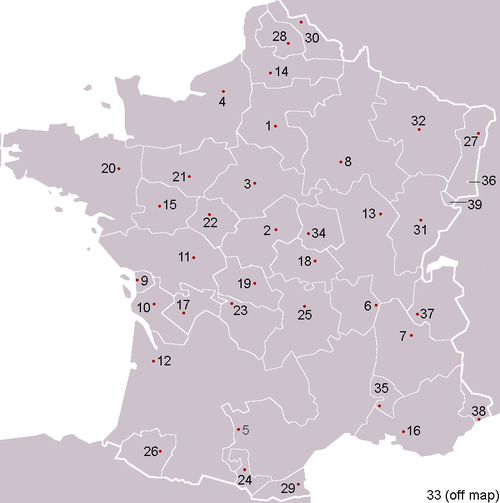Perche

Perche (French pronunciation: [pɛʁʃ]) is a former province of northwestern France extending over the departments of Orne, Eure, Eure-et-Loir, Loir-et-Cher and Sarthe, which were created from Perche during the French Revolution.
Geography
Perche is bounded by Normandy to the north and west, Maine to the south-west, Vendomois and Dunois to the south, Beauce to the east and Thimerais to the north-east.
The greater part of the district is occupied by a semicircle of heights (from 650 to 1000 ft. in height) stretching from Moulins-la-Marche on the northwest to Montmirail on the south; within the basin formed thereby the shape of which is defined by the Huisne, an affluent of the Sarthe, lie the chief towns of Mortagne-au-Perche, Nogent-le-Rotrou and Bellême.

Economy
.svg.png)
Stock-raising and dairy-farming are flourishing in the Perche, which is famous for the production of a breed of large and powerful horses, called Percherons. Cider-apples and pears are grown throughout the district.
History
In the Middle Ages, the Count of the Perche (Comté du Perche) governed the region between Normandy and Maine, of which Corbon, Mortagne and Nogent-le-Rotrou were successively the capitals. It was held by an independent line of counts until 1226. Geoffroy V, comte du Perche, would have been a leader of the Fourth Crusade had he not died before the assembled forces could depart.
The county then became a possession of the crown, which removed part of it to create the county of Alençon. After 1325, both counties were generally held by a member or members of a cadet branch of the House of Valois. Upon the death without children of the last Duke of Alençon in 1525, the countship returned to the crown, and was granted only sporadically thereafter.
Under the ancient regime it formed, together with Maine, a government of which Mortagne was the capital. It had its own customary law (the "coûtume du Perche") until the French Revolution.
Source of emigrants
In the 17th century, a large proportion of immigrants to New France came from Perche, in what has been called the "Percheron immigration".[1] Many Percherons were recruited in the 1630s and 1650s to work for the church missionaries and the nobles who were establishing estates on the Saint Lawrence River. While the total number of emigrants was small, Perche had a much higher rate of emigration to New France than most other regions of France. Nearly all French Canadians have some ancestors from the villages of Perche.
See also
References
- ↑ "The Gathering". A point in history. Retrieved 8 October 2016.
 This article incorporates text from a publication now in the public domain: Chisholm, Hugh, ed. (1911). "article name needed". Encyclopædia Britannica (11th ed.). Cambridge University Press.
This article incorporates text from a publication now in the public domain: Chisholm, Hugh, ed. (1911). "article name needed". Encyclopædia Britannica (11th ed.). Cambridge University Press.
External links
- Le Perche, emigration to Quebec in the 17th century
- Perche in the New York Times’ T-Style magazine
